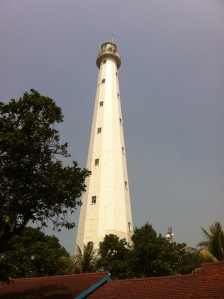Today was the second last day of our project. Therefore, we took the opportunity to travel around the Banten area. We set off quite early because it would be a long journey and we packed the necessary road trip items such as drinks and Keropok. The first stop of our trip was the coastal town of Anyer. Anyer overlooks the Sunda Straits and on a clear day, the infamous Krakatau could be seen. We did not manage to see Krakatau but we managed to scale a 40 metre tall lighthouse. This lighthouse was constructed by King Willem III of the Netherlands in 1885 as a memorial for the people who lost their lives during the eruption. The top of the lighthouse commands a great view of the surrounding area and the seemingly endless sea and the view up there was breathtaking. After Anyer, we got back on our journey and made our way towards Serang. On our way to Serang, we traversed through the highlands of Banten. Peering through the window of the vehicle, we were welcomed by a beautiful lush green landscape, dotted with terraced Padi fields and majestic mountains. The view was spectacular and it reminded me of my mountain trekking days. Before heading to Serang, we went to a town to buy some authentic Javanese coffee. The shop that we bought the coffee had a rustic look and the smell of coffee permeates his shop. Even, a non-coffee drinker like me was tempted to purchase some coffee to try. When we reached Serang, it was already dark and we bought our dinner there before heading back to ‘MESS’. This road trip around the Banten area was truly an experience I would never forget and it was all thanks to Pak Sonny Wibisono, Ibu Naniek Harkantiningsih and Pak Sarjiyanto.
Love,
Michael














